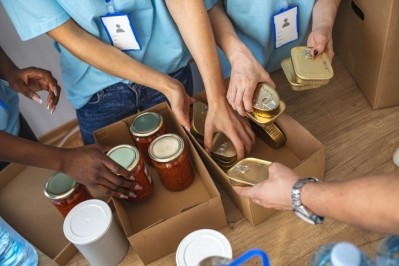Ongoing obesity epidemic among children sparks call for expanded nutrition benefits, stricter school meal standards

The second annual State of Childhood Obesity report published Oct. 14 also reaffirms obesity, and its related risks, are more likely to afflict children who are Black, Hispanic, American Indian/Alaska native and Native Hawaiian/Pacific Islander than white or Asian youth – a disparity that the authors argue is not a coincidence, but rather “a result of policies, decisions and disinvestment that put millions of Americans – children and adults – at risk for poor health, chronic disease and even death.”
A potential silver lining of the pandemic’s disproportionate impact on these groups is “an unprecedented opportunity to rethink policies and redesign programs to prevent disease and better promote health for all,” but especially those who have been systematically disenfranchised, the report argues.
Specifically, the report reiterates calls to raise the maximum Supplemental Nutrition Assistance Program benefits and reduce barriers to access the program; ensure school meal programs continue to have flexibility to serve children outside of school, and provide Women Infant and Children program offices with technical support to serve families. The report also highlights how limiting marketing and access to sugary drinks as well as taxing the beverages can help all children, while also closing the health disparity gap between different racial and ethnic groups.
Connecting the dots between nutrition, race and health outcomes
While the rate of obesity among 10- to 17-year-olds in 2018-19 fell slightly to 15.5% compared to 16.1% in 2016, the difference was not statistically significant, and when the age range is expanded to include 2- to 19-year-olds the rate of obesity climbed to 19.3% in 2017-2018 -- the highest in nearly 20 years with the rate in 1999-2000 coming in at 13.9%.
In addition, the data shows racial and ethnic disparities in obesity rates persist, according to the report, which pulls data from several federal surveys, including the National Health and Nutrition Examination Survey, the National Survey of Children’s Health, the WIC Participant and Program Characteristics Survey, and the Youth Risk Behavior Surveillance System.
According to data just from the National Survey of Children’s Health, obesity rates are highest among Native Hawaiian and other Pacific Islanders at 39.8%, followed by American Indian and Alaskan Natives at 28.5%, Blacks at 22.9%, and Hispanics at 20.7%. Only whites and Asian-American children suffer obesity at rates lower than the national level at 11.7% and 5.9% respectively.
“There are also disparities by income level,” according to the report, which notes 21.5% of youth in households living below the federal poverty level suffer obesity – a figure that is more than double the 8.8% of children from wealthier homes making at least 400% above the federal poverty level.
“When you think about why that is, there are a number of different factors. Some have to do with exposure, but so much has to do with opportunities to make healthy choices. Who has opportunities for healthy eating and for health activities, and for the types of behaviors that will reduce the risk for obesity,” Richard Besser, president and CEO of the Robert Wood Johnson Foundation, notes in the report.
For many children, access to a regular source of healthy meals depends on child-care centers and schools, many of which have been closed since the COVID-19 outbreak – prompting policy changes to improve access to nutrition and promote better health, according to the report.
“To date, emergency relief measures in response to COVID-19 have increased support for nutrition assistance programs and allowed more flexibility to help prevent hunger and extend resources to those in need,” the report notes. “But there is much more work to be done. Moving forward, leaders at all levels must seek new opportunities to strengthen and modernize policies to support healthier child-care settings, schools and communities.”
Increase SNAP benefits 15%
For example, the report argues strengthening and expanding federal nutrition assistance programs, such as SNAP, could help more families purchase healthy food, which in turn could lower obesity and other health risks.
“Children with access to SNAP show lower risk for high blood pressure, heart disease, diabetes and other poor health outcomes as they get older,” the report notes.
It also acknowledges that Congress pass legislation in March that temporarily suspended SNAP work requirements, allowed states to request emergency benefits and gave extra benefits to some SNAP recipients. However, it noted the extra funds were not enough to increase total benefits for participants or expand eligibility, which the report argues would help more children.
Raising the maximum SNAP benefit by 15% per participant during the pandemic and economic downturn not only would improve children’s health but also boost their academic performance, stimulate the economy and increase farm income, the report adds.
Expand access to WIC
In addition to expanding SNAP, the report argues USDA and Congress should expand access to WIC in the short term, and longer term extend eligibility to postpartum mothers through the first two years of their children’s lives and to children through age six to align with participation in the school meal program.
Also, the report advocates that “policymakers should work to increase racial equity in WIC participation, including making WIC packages more culturally inclusive, providing targeted support based on health disparities, and providing breastfeeding support that is inclusive and relevant for women of color who participate in WIC.”
Other suggestions include funding WIC’s Breastfeeding Peer Counseling Program at its full authorized amount, modernizing WIC services through technology and updating the WIC food package based on nutritional science.
Support school meals
Given how many children rely on school meals for their nutrition, the report urges the ongoing flexibility for schools to feed children even when classes are virtual, and to serve free meals to all students in high-poverty areas regardless of family income.
In addition, the report urges USDA to maintain nutrition standards for school meals that were in effect prior to a final rule in December 2018 that eased requirements around whole grains, sodium and milk. https://www.foodnavigator-usa.com/Article/2020/04/16/Court-strikes-USDA-rule-that-eliminated-stricter-school-meal-nutrition-standards

















